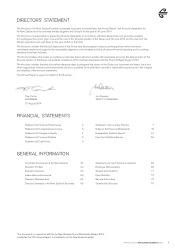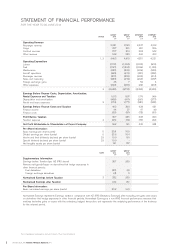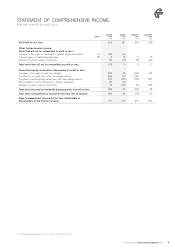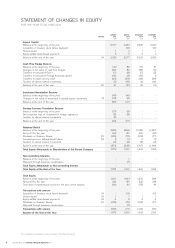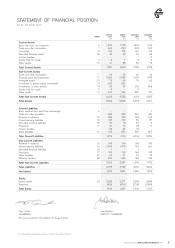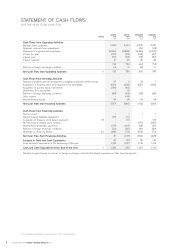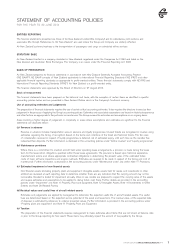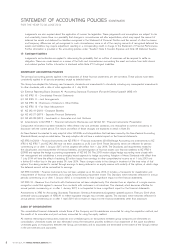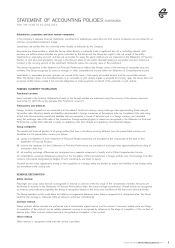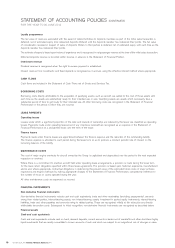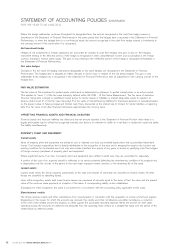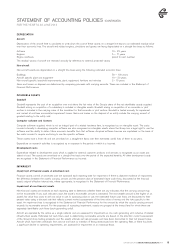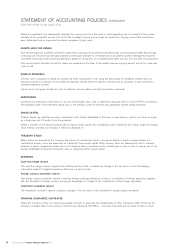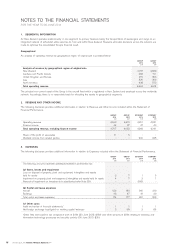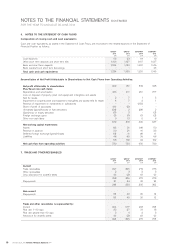Air New Zealand 2014 Annual Report Download - page 10
Download and view the complete annual report
Please find page 10 of the 2014 Air New Zealand annual report below. You can navigate through the pages in the report by either clicking on the pages listed below, or by using the keyword search tool below to find specific information within the annual report.
AIR NEW ZEALAND ANNUAL FINANCIAL RESULTS 20148
Judgements are also required about the application of income tax legislation. These judgements and assumptions are subject to risk
and uncertainty, hence there is a possibility that changes in circumstances will alter expectations, which may impact the amount of
deferred tax assets and deferred tax liabilities recognised in the Statement of Financial Position and the amount of other tax losses
and temporary differences not yet recognised. In such circumstances, some or all of the carrying amounts of recognised deferred tax
assets and liabilities may require adjustment, resulting in a corresponding credit or charge to the Statement of Financial Performance.
Further information is provided in the accounting policies under “Taxation”, Note 4 Taxation Expense and Note 23 Deferred Taxation.
(f) Contingent liabilities
Judgements and estimates are applied to determining the probability that an outflow of resources will be required to settle an
obligation. These are made based on a review of the facts and circumstances surrounding the event and advice from both internal
and external parties. Further information is disclosed within Note 27 Contingent Liabilities.
SIGNIFICANT ACCOUNTING POLICIES
The principal accounting policies applied in the preparation of these financial statements are set out below. These policies have been
consistently applied to all periods presented, except as detailed below.
The Group has adopted the following new framework, standards and amendments to standards, including any consequential amendments
to other standards, with a date of initial application of 1 July 2013.
(a) External Reporting Board Standard A1 “Accounting Standards Framework (For-profit Entities Update)” (XRB A1)
(b) NZ IFRS 10 - Consolidated Financial Statements
(c) NZ IFRS 11 - Joint Arrangements
(d) NZ IFRS 12 - Disclosure of Interests in Other Entities
(e) NZ IFRS 13 - Fair Value Measurement
(f) NZ IAS 19 (2011) - Employee Benefits
(g) NZ IAS 27 (2011) - Separate Financial Statements
(h) NZ IAS 28 (2011) - Investments in Associates and Joint Ventures
(i) Amendments to NZ IFRS 7 - Financial instruments: Disclosures and NZ IAS 32 - Financial Instruments: Presentation
Comparative information has been restated to reflect these new and amended standards, and reclassified to achieve consistency in
disclosure with the current period. The nature and effect of these changes are explained in detail in Note 30.
Air New Zealand has elected to early adopt all other NZ IFRSs and Interpretations that had been issued by the New Zealand Accounting
Standards Board, except as noted below. The early adoption did not have a material impact on the financial statements.
NZ IFRS 9 (2010) - Financial Instruments and NZ IFRS 9 - Financial Instruments (2013) (Hedge Accounting and amendments to NZ
IFRS 9, NZ IFRS 7 and NZ IAS 39) have not been adopted as at 30 June 2014. These Standards, which are effective for periods
commencing on or after 1 January 2017, will be adopted with effect from 1 July 2014. The Standards add requirements related to
the classification and measurement of financial liabilities, and derecognition of financial assets and financial liabilities to NZ IFRS 9
(2009) and replace the hedge accounting requirements of NZ IAS 39. The 2013 version aligns hedge accounting more closely with
risk management and establishes a more principles based approach to hedge accounting. Adoption of these Standards with effect from
1 July 2014 will have the effect of restating $2 million losses from earnings to other comprehensive income as at 1 July 2013 and
a further $1 million loss in the year ended 30 June 2014. These changes relate to the change in treatment of the time value of fuel
options from being marked to market through earnings to being deferred in an equity reserve until maturity of the options, at which stage
the deferred amount will be reclassified to earnings.
NZ IFRS 9 (2014) - Financial Instruments has not been adopted as at 30 June 2014. It includes a framework for classification and
measurement of financial instruments and a single, forward-looking impairment model. This Standard, which becomes effective for annual
periods commencing on or after 1 January 2018, is not expected to have a significant impact on the financial statements.
NZ IFRS 15 - Revenue from Contracts with Customers has not been adopted early. This standard has an objective of a single revenue
recognition model that applies to revenue from contracts with customers in all industries. This standard, which becomes effective for
annual periods commencing on or after 1 January 2017, is not expected to have a significant impact on the financial statements.
Amendments to XRB A1 Accounting Standards Framework: Omnibus Amendments (Legislative update) issued in February 2014 which
amended various paragraphs of XRB A1 to reflect legislative changes has not been applied. This standard, which becomes effective for
annual periods commencing on or after 1 April 2014 will not have an impact on the financial statements other than disclosure.
BASIS OF CONSOLIDATION
The consolidated financial statements include those of the Company and its subsidiaries, accounted for using the acquisition method, and
the results of its associates and joint ventures, accounted for using the equity method.
All material intercompany transactions, balances and unrealised gains on transactions between group companies are eliminated on
consolidation. Unrealised losses are also eliminated unless the transaction provides evidence of an impairment of the asset transferred.
Unrealised gains on transactions between the Group, joint ventures and its associates are eliminated to the extent of the Group’s interest
in the joint ventures and associates.
STATEMENT OF ACCOUNTING POLICIES (CONTINUED)
FOR THE YEAR TO 30 JUNE 2014



